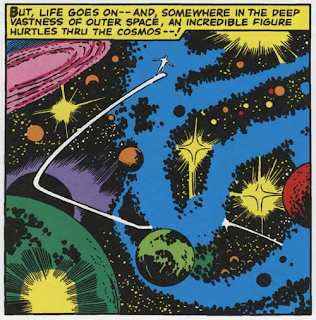
In my last post on invisible rays I mentioned the fact that Jack Kirby had devoted much of his career to the depiction of both physical and psychic energies. I have also decided to devote a full post to this issue because a blog on drawing at some point has to acknowledge the influence of Jack Kirby on any artist who read American superhero comic books when growing up in the 1960s. I have in the past referred to Steve Ditko's surreal visionary landscapes, that made up the backgrounds of Doctor Strange comics, but it was Jack Kirby that developed visual languages that gave me an insight into the possibilities of depicting invisible energies.
I'm not alone in recognising Kirby's importance when it comes to visualising cosmic energies, Jeffery Kripal has stated;
'For Kirby, the human body is a manifestation or crystallization of finally inexplicable energies... What Mesmer called animal magnetism, Reichenbach knew as the blue od and Reich saw as a radiating blue cosmic orgone becomes in Jack Kirby a trademark energetics signaled by "burst lines" and a unique energy field of black, blobby dots that has come to be affectionately known as the "Kirby Krackle" ... The final result was a vision of the human being as a body of frozen energy that, like an atomic bomb, could be released with stunning effects, for good or for evil. These metaphysical energies, I want to suggest, constitute the secret source of Kirby's art'. (Kripal, 2011, p. 286 )
Kirby Krackle is also known in the comic book trade as Kirby Dots, when depicting a directional energy ray rather than an energy field. These overlapping dots are a way of visualising a crackle of energy such as a lightning bolt or what has been called in comic book jargon, 'a battle aura', This is a visual sign that lets the comic book reader know that the hero or villain is psyching themselves up for battle. They are drawn as emitting a coruscating, Kirlian-like glow around their bodies as a sign of great inner power.The technique consists of drawing a series of overlapping spots or dots along the edge of the energy effect being created, and as you do so you create a white negative space that begins to optically oscillate.
The Op artist Bridget Riley was using a similar effect at the same time, but Kirby was more organic in his approach, which allowed him to be more suggestive in his metaphoric impact. When I was teaching, an interesting visual exercise for Foundation students, was to take a regular grid and begin to set out dots within it. Then to distort the grid and to make the dots follow the distortion. You can do this within a grid made by using curved perspectives if you want to be spatially playful.
There now exists a CGI tool for automatically creating Kirby Dots, and an analogous technique called 'particle emission' is used in video game graphics for rendering particle emissions and energy fields.
By combining the dots with lines, especially if the lines were in a deep perspective, Kirby (and other artists working with him) was able to give an idea of a sudden blast of energy, as in an explosion.
Kripal, Jeffrey J. (2011). Mutants and Mystics: Science Fiction, Superhero Comics, and the Paranormal. Chicago, IL: University of Chicago Press. pp. 286–287
Foley, Shane (November 2001). "Kracklin' Kirby: Tracing the advent of Kirby Krackle"Jack Kirby Collector. No. 33.
Pencil Jack online tutorial for Kirby Krackle
See also:
Parascientific visions and Rayonism











No comments:
Post a Comment